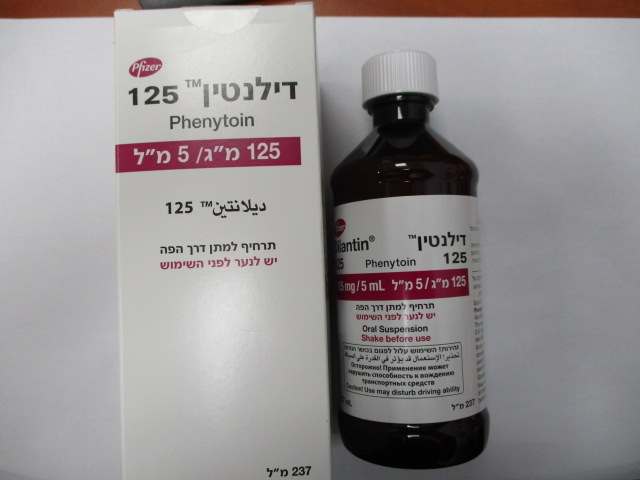Quest for the right Drug

דילנטין 125 DILANTIN 125 (PHENYTOIN)
תרופה במרשם
תרופה בסל
נרקוטיקה
ציטוטוקסיקה
צורת מתן:
פומי : PER OS
צורת מינון:
תרחיף : SUSPENSION
עלון לרופא
מינוניםPosology התוויות
Indications תופעות לוואי
Adverse reactions התוויות נגד
Contraindications אינטראקציות
Interactions מינון יתר
Overdose הריון/הנקה
Pregnancy & Lactation אוכלוסיות מיוחדות
Special populations תכונות פרמקולוגיות
Pharmacological properties מידע רוקחי
Pharmaceutical particulars אזהרת שימוש
Special Warning עלון לרופא
Physicians Leaflet
Interactions : אינטראקציות
7 DRUG INTERACTIONS Phenytoin is extensively bound to plasma proteins and is prone to competitive displacement. Phenytoin is primarily metabolized by the hepatic cytochrome P450 enzyme CYP2C9 and to a lesser extent by CYP2C19 and is particularly susceptible to inhibitory drug interactions because it is subject to saturable metabolism. Inhibition of metabolism may produce significant increases in circulating phenytoin concentrations and enhance the risk of drug toxicity. Monitoring of phenytoin serum levels is recommended when a drug interaction is suspected. Phenytoin is a potent inducer of hepatic drug-metabolizing enzymes. 7.1 Drugs that Affect Phenytoin Concentrations Table 2 includes commonly occurring drug interactions that affect phenytoin concentrations. However, this list is not intended to be inclusive or comprehensive. Individual prescribing information from relevant drugs should be consulted. The addition or withdrawal of these agents in patients on phenytoin therapy may require an adjustment of the phenytoin dose to achieve optimal clinical outcome. Table 2: Drugs That Affect Phenytoin Concentrations Interacting Agent Examples Drugs that may increase phenytoin serum levels Antiepileptic drugs Ethosuximide, felbamate, oxcarbazepine, methsuximide, topiramate Azoles Fluconazole, ketoconazole, itraconazole, miconazole, voriconazole Antineoplastic agents Capecitabine, fluorouracil Antidepressants Fluoxetine, fluvoxamine, sertraline Gastric acid reducing H2 antagonists (cimetidine), omeprazole agents Sulfamethizole, sulfaphenazole, sulfadiazine, sulfamethoxazole- Sulfonamides trimethoprim Acute alcohol intake, amiodarone, chloramphenicol, chlordiazepoxide, disulfiram, estrogen, fluvastatin, isoniazid, methylphenidate, Other phenothiazines, salicylates, ticlopidine, tolbutamide, trazodone, warfarin Drugs that may decrease phenytoin serum levels Calcium carbonate, aluminum hydroxide, magnesium hydroxide a Antacids Prevention or Management: Phenytoin and antacids should not be taken at the same time of day Antineoplastic agents Bleomycin, carboplatin, cisplatin, doxorubicin, methotrexate (usually in combination) Antiviral agents Fosamprenavir, nelfinavir, ritonavir Antiepileptic drugs Carbamazepine, vigabatrin Chronic alcohol abuse, diazepam, diazoxide, folic acid, reserpine, Other rifampin, St. John’s wortb, sucralfate, theophylline Drugs that may either increase or decrease phenytoin serum levels Antiepileptic drugs Phenobarbital, valproate sodium, valproic acid a Antacids may affect absorption of phenytoin. b The induction potency of St. John’s wort may vary widely based on preparation. c Valproate sodium and valproic acid are similar medications. The term valproate has been used to represent these medications. 7.2 Drugs Affected by Phenytoin Table 3 includes commonly occurring drug interactions affected by phenytoin. However, this list is not intended to be inclusive or comprehensive. Individual drug package inserts should be consulted. The addition or withdrawal of phenytoin during concomitant therapy with these agents may require adjustment of the dose of these agents to achieve optimal clinical outcome. Table 3: Drugs Affected by Phenytoin Interacting Agent Examples Drugs whose efficacy is impaired by phenytoin Azoles Fluconazole, ketoconazole, itraconazole, posaconazole, voriconazole Antineoplastic agents Irinotecan, paclitaxel, teniposide Phenytoin can substantially reduce the concentrations of delavirdine. Delavirdine This can lead to loss of virologic response and possible resistance [see Contraindications (4)]. Cisatracurium, pancuronium, rocuronium and vecuronium: resistance to the neuromuscular blocking action of the nondepolarizing neuromuscular blocking agents has occurred in patients chronically Neuromuscular blocking administered phenytoin. Whether or not phenytoin has the same effect agents on other non-depolarizing agents is unknown. Prevention or Management: Patients should be monitored closely for more rapid recovery from neuromuscular blockade than expected, and infusion rate requirements may be higher. Increased and decreased PT/INR responses have been reported when Warfarin phenytoin is coadministered with warfarin Corticosteroids, doxycycline, estrogens, furosemide, oral Other contraceptives, paroxetine, quinidine, rifampin, sertraline, theophylline, and vitamin D Drugs whose level is decreased by phenytoin Anticoagulants Apixaban, dabigatran, edoxaban, rivaroxaban Carbamazepine, felbamate, lamotrigine, topiramate, oxcarbazepine, Antiepileptic drugs a lacosamide Antilipidemic agents Atorvastatin, fluvastatin, simvastatin Antiplatelets Ticagrelor Efavirenz, lopinavir/ritonavir, indinavir, nelfinavir, ritonavir, saquinavir Antiviral agents Fosamprenavir: phenytoin when given with fosamprenavir alone may decrease the concentration of amprenavir, the active metabolite. Phenytoin when given with the combination of fosamprenavir and ritonavir may increase the concentration of amprenavir Calcium channel blockers Nifedipine, nimodipine, nisoldipine, verapamil Albendazole (decreases active metabolite), chlorpropamide, clozapine, Other cyclosporine, digoxin, disopyramide, folic acid, methadone, mexiletine, praziquantel, quetiapine a The effect of phenytoin on phenobarbital, valproic acid and sodium valproate serum levels is unpredictable 7.3 Hyperammonemia with Concomitant Use of Valproate Concomitant administration of phenytoin and valproate has been associated with an increased risk of valproate-associated hyperammonemia. Patients treated concomitantly with these two drugs should be monitored for signs and symptoms of hyperammonemia. 7.4 Drug Enteral Feeding/Nutritional Preparations Interaction Literature reports suggest that patients who have received enteral feeding preparations and/or related nutritional supplements have lower than expected phenytoin serum levels. It is therefore suggested that phenytoin not be administered concomitantly with an enteral feeding preparation. More frequent serum phenytoin level monitoring may be necessary in these patients. 7.5 Drug/Laboratory Test Interactions Care should be taken when using immunoanalytical methods to measure serum phenytoin concentrations.

שימוש לפי פנקס קופ''ח כללית 1994
Grand mal & psychomotor seizures, trigeminal neuralgia
תאריך הכללה מקורי בסל
01/01/1995
הגבלות
תרופה שאושרה לשימוש כללי בקופ'ח
מידע נוסף
עלון מידע לרופא
31.05.22 - עלון לרופאעלון מידע לצרכן
04.01.16 - עלון לצרכן 24.02.16 - עלון לצרכן 16.08.20 - עלון לצרכן אנגלית 31.05.22 - עלון לצרכן אנגלית 31.05.22 - עלון לצרכן עברית 16.08.20 - עלון לצרכן ערבית 31.05.22 - עלון לצרכן ערבית 28.02.12 - החמרה לעלון 06.05.12 - החמרה לעלון 17.11.14 - החמרה לעלון 13.06.21 - החמרה לעלון 18.04.22 - החמרה לעלוןלתרופה במאגר משרד הבריאות
דילנטין 125